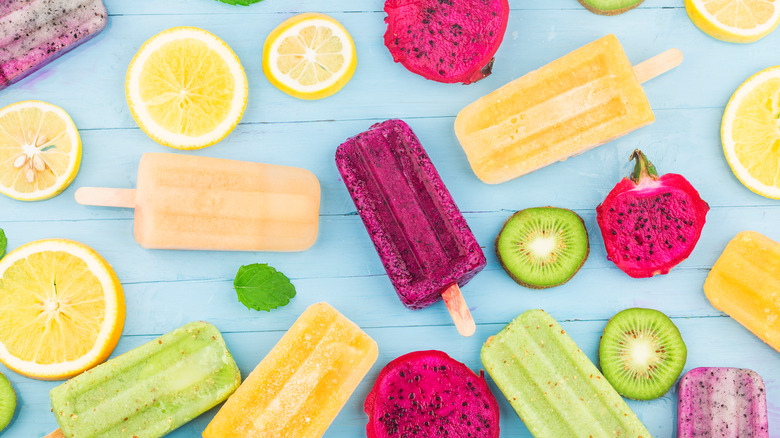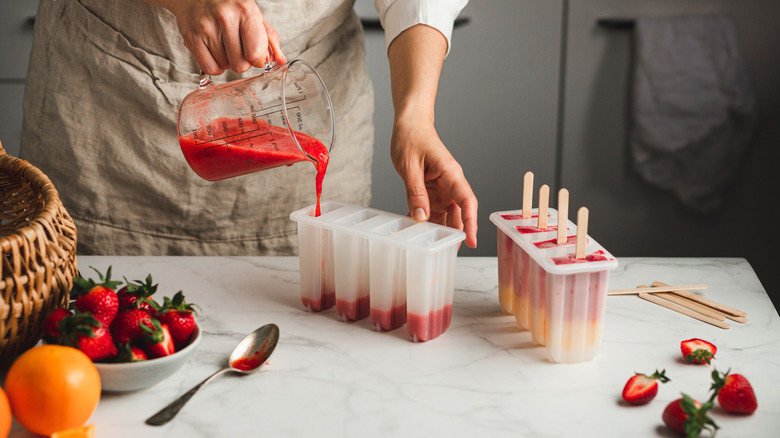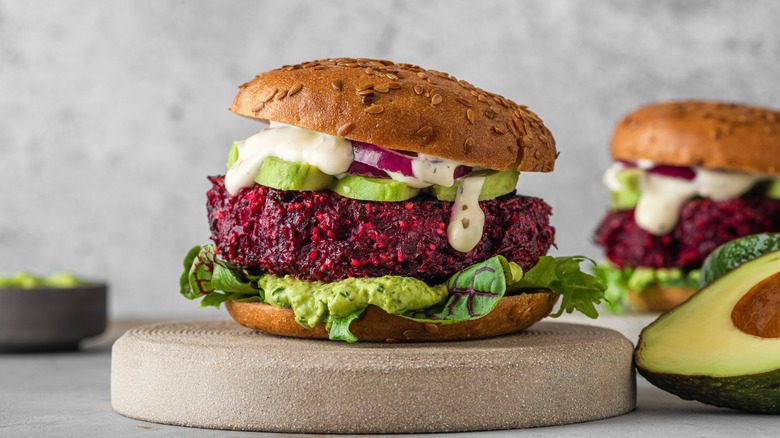Stop Tossing Out Leftover Fruit Pulp And Turn It Into 'Pulpsicles'
If you've spent any time in the kitchen, you know that cooking from scratch generates a lot of waste. But what you may not be aware of is that food scraps can actually do a lot of damage after they've been tossed in the trash. Without getting too deep into the science here, when organic matter (like food scraps) ends up in a landfill, it slowly decomposes beneath a mountain of (primarily) inorganic garbage. This process, technically known as anaerobic decomposition, results in the release of harmful greenhouse gasses that contribute to a warming planet and climate change.
Sure, you can always get rid of your organic waste through composting, but it's more fun (and economical) to find some culinary uses for those extra food scraps. And there's a lot of ideas to choose from! You can easily turn potato peels into chips, watermelon rinds into kimchi, broccoli stems into fries, and other veggie leftovers into a potent vegetable stock.
But if you're a home juicer, your food scrap of choice is likely fruit and vegetable pulp. There's a lot you can do with pulp, but one of the simplest applications is to make popsicles, or the infinitely cuter, pulpsicles. Pulp from lemons, oranges, apples, and mangoes are all terrific options but don't shy away from more savory ingredients, like carrots or beets, which can add unique colors and flavor notes to your frozen treats.
Turning pulp into a guilt-free frozen treat
When it comes to making pulpsicles, the pulp itself is a supplementary ingredient that needs to be paired with a liquid base, such as fresh fruit or vegetable juice. In addition to your juice base, you can pour in any variety of creamy additions, like yogurt, milk, or a non-dairy alternative, or, if you're feeling risqué, some heavy cream or condensed milk. Depending on your combination of juices and dairy products, you may want to add a sweetener. Honey, maple syrup, or agave are all good options. Cornstarch is another secret ingredient you can add to your pulpsicles to prevent them from turning into ice blocks.
To construct your pulpsicle, remember to add your pulp to the mold before pouring in the liquid base. After freezing for eight hours, they should be ready to go. Funnily enough, extracting the pulpsicles from their molds may be the trickiest part of the whole process. If you've made popsicles before, this should be no problem; if not, just run the molds under warm water for 30 to 60 seconds.
Other clever ways to repurpose your pulp
Fruit and vegetable pulp has a nutritional profile that reads like a health tonic. The stuff is loaded with fiber and, depending on the specific type of pulp, may also contain a range of vitamins, minerals, and antioxidants. Since pulp retains much of the original ingredient's color and flavor, it can be a tasty addition to any number of recipes.
One idea is turning your pulp into crackers by mixing the pulp (vegetable pulp works best) with some flour, water, and seasonings. Or, if you have extra fruit pulp, try dehydrating it at a low temperature until it has a chewy consistency for your own homemade fruit leather. Another way to use your pulp is to add it to your baked goods, like banana bread, cupcakes, or muffins. This not only boosts the nutritional profile of the pastry or bread but also moistens the final product, which may actually cut the need for extra oil or fat. If you're in the mood for something on the savory side, then go for a pulp-packed veggie burger. And if none of the above appeals to your tastes, you can always turn your pulp into nutritious dog treats for your furry four-legged friends!


